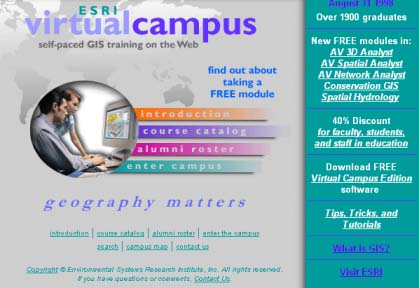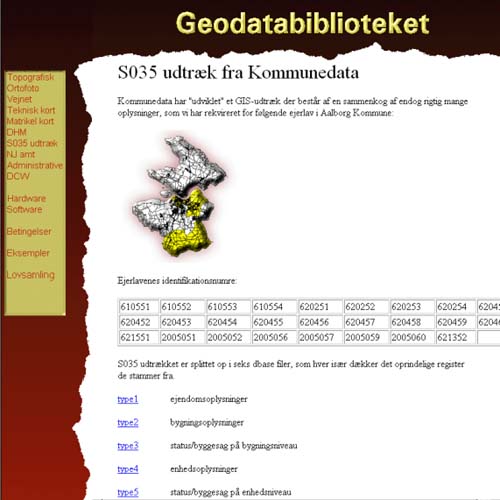 |
| THE USE OF LOCAL DATA IN Esri VIRTUAL CAMPUS |
| Jan Kloster Staunstrup The Department of Development and Planning, the Faculty of Technical and Natural Sciences & the Faculty of Social Sciences, Aalborg University, Fibigerstraede 11, DK-9000 Aalborg, Denmark, phone +45 9635 8336, fax +45 9815 3537, jks@i4.auc.dk Torben Hedegaard Abstract In the Department of Development and Planning at Aalborg University education and research programs are carried out at various levels within the sphere of GIS. In most of these programs training is required for operating a GIS, training that has up to now been offered as traditional lectures alternated by hands-on sessions. However, with the Esri Virtual Campus new possibilities have emerged. A ‘localized extension’ to the Virtual Campus is now being developed in our department in cooperation with the Esri team. The idea is to make exercises available, based on local data, as a part of the Virtual Campus training modules. We consider this important, because the default exercises of course are based on US data, which are in many respects much different from Danish – and other European data. Assignments built on data, that are familiar to the trainees, will appear motivating, and probably make the training more rewarding for the individuals involved. We would like to present our results so far, to the European Esri user community, together with some work still in progress. We believe, that our experience, and our work together with the very kind and cooperative Virtual Campus development team, may be beneficial to many others users in Europe. A further perspective could even be the development of an ‘EU Virtual Campus’ based on common European data sets. Such data would be much more relevant and comprehensible for the users in Europe than American data. Figure 1 INTRODUCTION Tremendous innovations within production-, presentation-, and storage possibilities have now for a couple of decades clearly demonstrated for all users of spatially related data, that ‘tomorrow’s world’ becomes more and more different from ‘the world of today’. The shift from production of paper- or analogue maps, and the use of the traditional expensive, times consuming data collection methods, towards sophisticated new technological solutions, has changed the agenda for the users. But not only for how data are collected and assembled, but also how they are used, what they are used for, and who the users are. This development is followed by a very high knowledge turnover, which is even increasing every year. The period from the time when theories, competence and skills are up to date until they are out of date is becoming ever shorter. TECHNOLOGICAL INNOVATION The technological development has caused many changes in the working processes of professional environments like for example those where spatial data are used. The primary change is the drop in prices and the technological development in computing power, which has changed work processes and tasks. During the 70s especially the computing routines for production of co-ordinates and digital maps were developed, and the first spatial database systems were put to use. In the 80s media integrating desktop computers or PCs made possible to work with different systems on the same machine and from the middle of the decade we saw GIS software becoming a prominent tool in the PC world. During the 90s almost unbelievable IT innovations have been in focus, and at the same time prices have continued to drop at extreme speed. The appearances of the Internet, standardized digital communication, and data exchange have highly influenced the professional environment. The ‘land slide’ within information and communication technology during the past five years has brought along gigantic changes – and it appears to continue at the same high speed. SCIENCE AND EDUCATION A consequence of these changes is an increasing demand of education and scientific research. In the Department of Development and Planning at Aalborg University research within technical and theoretical issues of production and use of spatial data has taken place since the university was founded in 1974. In 1990 the GISplan Research Group was established, as a liaison platform between different research units in the Department, all with strong interests in spatial data. GISplan ( http://www.i4.auc.dk/gisplan/default.htm ) is a research program on geographical information systems in environmental infrastructure and urban planning. The program objective is to describe a formal platform for the development of integrated information systems within a coherent geographical space, where a series of basic data will be available in digital form. GISplan is also a physical place, where equipment and data are present to be worked with. What could then be more natural, than to use this environment for the storing of such digital data that is much needed not only by the various research units, but also for the undergraduates working with a range of spatial data ‘consuming’ projects? Therefore, in order to support the many fields of scientific work, and to strengthen the environment of research based education taking place at the university, the development of a Spatial Data Library was initiated early in 1997. This library has since become fully operational and now contains samples of all kinds of spatially related data that are used for scientific – as well as professional purposes in Denmark. Figure 2 During recent years, through the work in GISplan, qualifications for research and education in regard to multimedia and information technology connected with spatially related information have been seriously upgraded. The know-how obtained has made possible to focus upon, and develop interdisciplinary research and problem-orientated expertise as regards geographic information, and the implementation of such technology. Some parts of the syllabus and teaching process is completely renewed, in order to meet the challenges that follows the change towards almost entirely digital work conditions. Consequently contemporary, and comprehensive data must be available within the department for students as well as scientist as fundamental users of the library. Also students and scientists from other departments of Aalborg University will get access to most of the Spatial Data Library, and they are expected to become another significant group of users. In the wake of the scientific results in GISplan, new education options have seen the light of day. One field of education particularly is the focal point at present time: - post graduate Master Study Programs, made possible on large scale by the use of modern distant learning techniques. In the Department of Development and Planning such a study was initiated in September 1996. This Master of Technology Management program (MTM) in Geo Informatics is one of several similar studies offered and administered by the Open University organisation at Aalborg University. Other post graduate education programs with various levels of spatial data requirements presently are in the melting pot or have been started already. I connection with this kind of career building educational activities, the needs for high quality and current spatial data can only be expected to grow in coming years. GIS TRAINING One of the important issues of the Spatial Data Library is to provide data sets for GIS training programs in our department. That kind of training is necessary - as a secondary target - in order to make possible for the students to operate such GIS software packages, which may be required to fulfill tasks within the study program. When Esri introduced the ‘Virtual Campus’ on the Internet last year, we immediately realized the new possibilities and the relief this could mean for us. We would much prefer to direct our education efforts towards the theoretical aspects of GIS, whereas system training could much better be taken care of by the specialists who develop the software. But then we would also have to accept the kind of foreign data provided as basis for the training. Our students and scientists of course would feel much more familiar with local data and understand it better. If we only could make it possible to use our own spatial data within the Esri Virtual Campus the drawback would not exist any more – an attractive thought !!! Last year, during the 12th Esri European User Conference in Copenhagen, Jan Staunstrup and I met Jim Henderson, the Manager of International Technical Marketing Support at the Esri headquarter in Redlands, California. We discussed our idea of using local Danish data in connection with their training program. Jim reacted most positively, and as a result early this year I visited Esri, and had some very good discussions with a highly co-operative Virtual Campus development team. Esri suggested that links should be created directly from the Virtual Campus to our Internet server, so that anybody using their training could choose exercises made by us. Of course mostly Danish users would be interested in this option, but maybe some other Scandinavians would as well find it attractive, because Danish data are probably also more recognizable to them than the American data generally used in the Virtual Campus. STATE AND PERSPECTIVE The idea is still on the ‘drawing board’, but we will to be able to present our first extension to the Virtual Campus later this year. The aim is to link a couple of exercises to each of the ArcView training modules. The users can then download our data sets. With these data sets, using their own ArcView software packages, they will be guided through the ‘localized hands on sessions’. The exercises will not be graded and should be regarded entirely as ‘self pace’ training, additional to the Virtual Campus standard modules. We know that our planned Virtual Campus extension is in great demand, not only by our university students, whom are of course our primary concern, but also by technicians and administrative personnel who need to develop various levels of skills for operating GIS software. Employers within the public sector as well as private companies are on the lookout for skilled GIS operators. Our extension will provide access - as easy as the access to the Esri Virtual Campus - to GIS training in the Danish language and with Danish data, which will attract precisely the kind of people who are much in demand. A further perspective is the possible ‘export’ of the model to other parts of Europe. In most European countries problems with the use of US-data must be the same as in Denmark. Thus we feel convinced, that our ‘model’ could be easily used by others, with own data and in own languages. |
     |
    |
 |
| [Introduction] [Conference programme] [Presentation by authors] [Presentation by category] [Poster session] [List of european Esri distributors] [List of exhibitor] [Esri products news] [Credits] |

